Hello WNVM-ers,
Cheryl here. Inspired by recent stories about MAC Cosmetics’ decline in popularity, I recently asked people on Instagram and Substack Notes to weigh in on which beauty brands from the ‘80s and ‘90s they couldn’t stop thinking about. I got a ton of responses. So I chose a few popular ones and traced their trajectories from hot to forgotten. In the process, I found some batshit stuff. Always follow the money.
Please pop in the comments and tell us which products and brands you’re curious about! I really want to make this a regular column, because there are a lot of zombie beauty brands kicking around out there still.
Then, a War of the Roses remake with an incredible cast, more celeb menopause BS, and dumb Jennifer Aniston/Pedro Pascal rumors.
You may need to view this in your browser so it doesn’t cut off.
You’re Fading Fast Out Of My Memory
Take a trip down beauty memory lane.
By Cheryl
Like Ruby Woo lipstick at the end of a long night, MAC Cosmetics seems to be slowly fading.
MAC has a Lipglass campaign now that is probably not a hail mary to get nostalgic people — who surely haven’t forgotten how often our hair got stuck in it — to try Lipglass again. It’s an appeal to younger generations who are enamored with a decade they never knew. Beauty brands always want the Youngs. But it has the unfortunate side effect of highlighting that its heyday may have been 30 years ago:
“Being thought of in the past-tense is the kiss of death for any brand, let alone one that always considered itself ahead of the curve,” writes Anne-Marie Guarnieri at Starving For Beauty, in her smart analysis about what has gone wrong at MAC.
It’s a tale as old as a Trapper Keeper: Users age out of a brand, and something newer and cooler comes along to take its place. In the age of social media, this turnover cycle is happening more quickly. (The exception is Clinique’s Black Honey lipstick, which gets “discovered” every three years or so: It’s “Grandma approved”!)
MAC, founded in 1984 and now owned by Estée Lauder, is still huge and in no danger of going out of business anytime soon. But we are watching it struggle for relevance in real time. It got me thinking about the many beloved and popular brands and products from the past that have seemed to just disappear. What really happened to them? I’m going to tell you!
Hard Candy
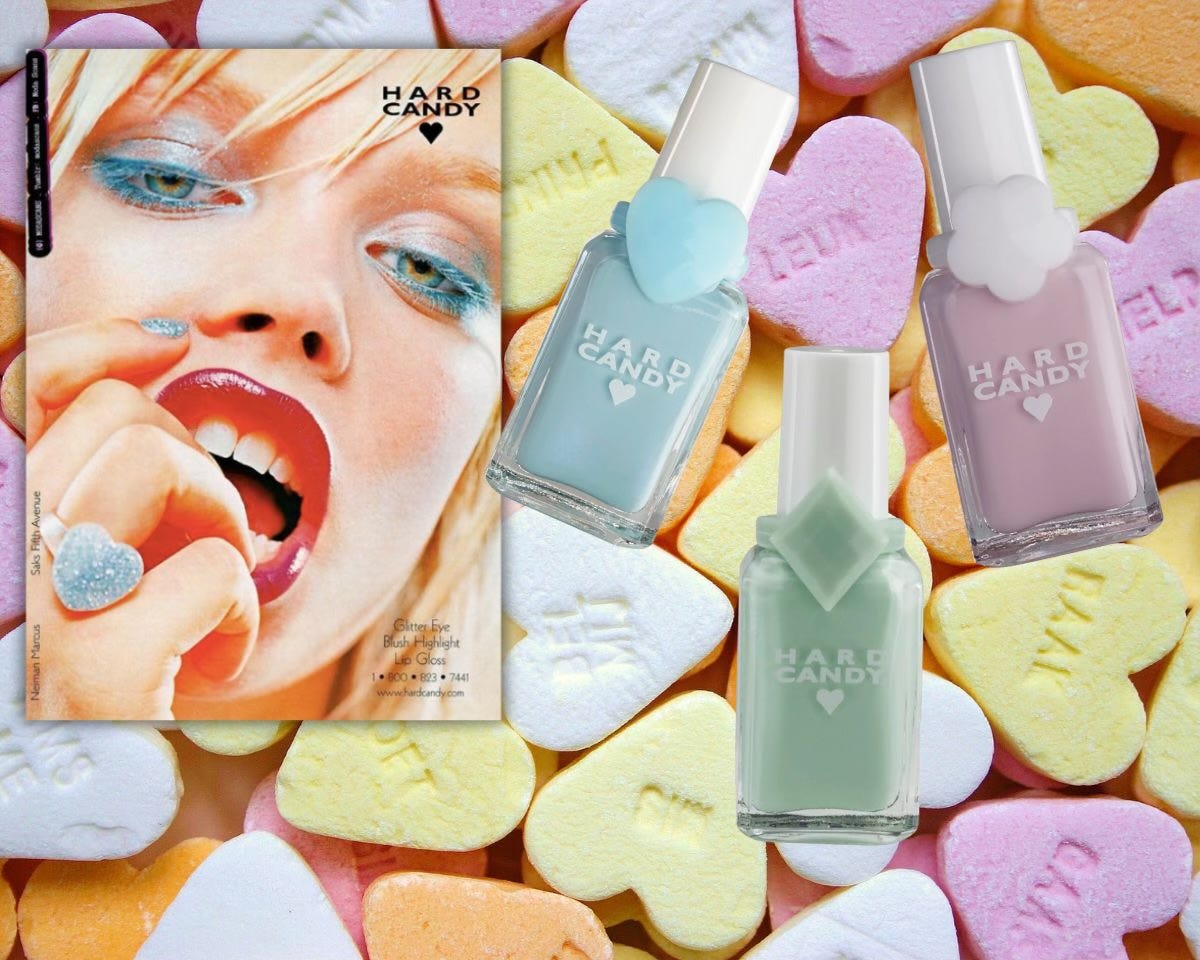
Hard Candy, and its pastel polishes with cheeky shade names, upended the staid nail polish industry in the ‘90s. In 1995, then-premed-student Dineh Mohajer founded the brand, with the help of her sister and then-boyfriend. She told me in 2015 that she mixed Essie white (this was the height of French tips, after all) with “tacky” metallic blue that she found at a beauty supply store. The original “Sky” was born. She then started buying up bright colors and mixing them with the white in plastic deli ketchup bottles. While working at Fred Segal, her manager asked her if she wanted to sell the polish there. She also mailed bottles, topped with the soon-to-be signature cheap plastic rings, to all the major magazines. Then came Cher Horowitz.
Pivotal Brand Moments
1995-1996: An 18-year-old Alicia Silverstone, wearing “Sky” on her fingers and toes, goes on “Late Show with David Letterman” to promote Clueless. He grabs her hands (not OK, Dave!) and says, “It looks like it could be a circulatory problem.” Young people want the cyanosis look, because that shit sells out. It was truly groundbreaking. The following year Mohajer hires a CEO and gets the CNN treatment.
1997-1998: Hard Candy launches Candy Man, nail polish for guys, in colors like “Gigolo” and “Libido.” Dennis Rodman wears it. A Spy magazine blurb from December 1997 quotes Mohajer: “I’m not seeing it in Utah and Wyoming.” Other categories launch.
1999: Luxury conglomerate LVMH buys Hard Candy. My favorite quote from an exec on why it bought the young-skewing brand — and a reminder that we were once desired customers: “We’re broadening our product line to include Generation X consumers… Which doesn’t mean our other products are suffering from the grandma syndrome. We just want to cover a broader segment of the market.”
2003-2005: Mohajer is gone. Hard Candy never finds its groove. LVMH sells it and fellow ‘90s makeup darling Urban Decay to the Florida-based Falic Group. Falic owns Duty Free Americas, liquor brands, and fragrances like Perry Ellis; dabbles in media, interiors, and “distribution;” and runs a family philanthropic arm. Wende Zomnir, Urban Decay’s founder, takes on creative direction for both brands. They lower the price on Hard Candy and the words “girly, fun, and cool” get tossed around.
2009-2010s: None of that works. Hard Candy is pulled from all its retailers and re-emerges as a full Walmart-only makeup brand. It disappears from the zeitgeist in the age of indie brands like Morphe and Colourpop and #sponsored YouTube makeup influencers. Mohajer launches another (now defunct) nail-centric brand called Smith & Cult.
2018-2019: Hard Candy comes roaring back into the headlines because it tries to — WAIT FOR IT — trademark “#MeToo.” After a backlash, the company gives up the trademark application. A member of the Falic family tells Teen Vogue, in part: “We planned to donate 100% of all profits arising from this trademark to #metoo.” The next year, the AP publishes an investigation in which it finds that the Falic family’s philanthropic organization funds “controversial” Israeli West Bank settler groups and “far-right causes considered extreme even in Israel” at the time. (To be clear, it also donates to US charities, hospitals, and “the needy.”)
2025: The Falic organization hosts its charity golf outing at Trump’s golf club in Miami. Hard Candy currently has a collaboration with the Girl Scouts, famously welcoming of trans girls. This company makes really, erm, disparate choices.
What Now?
Hard Candy is an early example of how a brand got diluted over the course of multiple owners. It must be profitable, otherwise it wouldn’t be worth the company’s time. But it’s competing with a lot of other beauty brands and chasing trends instead of setting them (see: this lip oil packaging compared to products from Selena Gomez’s incredibly popular Rare Beauty brand.) And it’s going to have a harder go of it, because Walmart just announced that it’s upping its beauty offerings.
“Get Off My Lawn” final thought: Hard Candy doesn’t even make nail polish anymore, just press-ons. So it’s not even worth a nostalgia purchase.
Sun-In
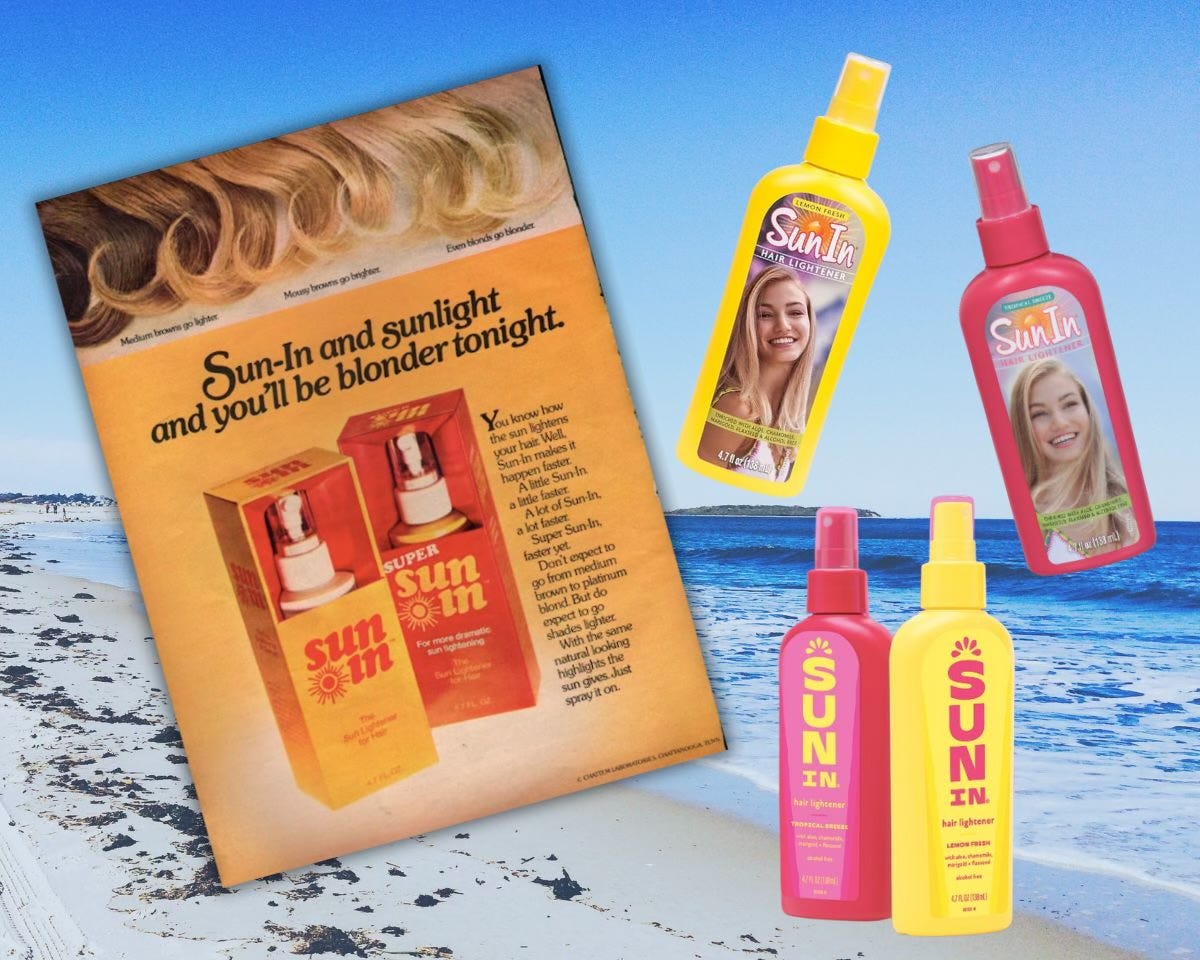
Sun-In, the concoction of hydrogen peroxide and lemon juice, has been around since the ‘60s. This means that at least four generations have been tempted to try it, sometimes to disastrous, orange-streaked, brittle results.
The allure of blond as a signifier for aspirational, white, Western-centric beauty and socio-economic superiority was probably a part of Sun-In’s draw for many decades. It certainly seemed to be prevalent in the packaging, marketing, and branding, and it surely sent a damaging message to POC. (Fawnia and her mom definitely thought so.) It also damaged a lot of hair. And yet the product persists.
(I consider myself very good at digging up ancient texts from the internet, but the name of this product makes it challenging to find news items unrelated to the actual sun. Bear with me for the lack of detail in some sections.)
Pivotal Brand Moments
1970s: Gillette owns the brand. Then, Tennessee-based pharmaceutical company, Chattem, buys Sun-In and Corn Silk cosmetics, among other things. (Fun fact: It also bought Love’s Baby Soft in 1980.) Please enjoy this unhinged, offensive paragraph from a 1971 Schenectady newspaper. It’s not clear if it’s an early advertorial or an article, but wow:
1988: “Chattem added two new variations of its Sun-In Hair Lightener product to store shelves when it unveiled Gentle Highlights and Natural Lemon Sun-In. The gentle variety was targeted at younger first-time users, and Natural Lemon was a means of capturing reluctant clientele.” This was green-washing before that was a thing. Also: HMM, WONDER WHY SOME CLIENTELE MIGHT HAVE BEEN RELUCTANT TO TRY IT?!
1989-1990s: Sun-In makes a rap commercial, which is a real…choice. See it below. It later adds something called “silkenol” to make hair softer and produces a commercial telling us we were “such a beautiful baby.”
2000s- 2010s: Sanofi, a giant French pharma company, buys Chattem. At some point, the brand starts putting pictures of blond white ladies on the bottle, which is creepy. Vogue recommends Sun-In.
2015: Some Chattem bros spin off and start a new company, Focus Consumer Healthcare. It acquires Sun-In.
2022-2024: There is a flurry of PR activity and several positive articles about Sun-In appear. Influencers hawk it on TikTok. In 2023, another pharma company, Kobayashi, buys Focus, primarily for its over-the-counter meds and supplements.
2025: Sun-In gets a glow up. Finally the company gets rid of the terrible bottles and goes back to its ‘80s roots with a bright pink and yellow color scheme and modern font. It even wins a packaging design award. The brand’s website features people with different hair colors and types and focuses on the lightening ability, downplaying the BLOND of it all.
What Now?
Sun-In is no longer the only hair lightener game in town, but it’s definitely the cheapest. There is a warning on the back that notes it can turn certain base shades a reddish color. The brand also has temporary neon hair colors called Fun-In, which I have to admit is clever.
“Get Off My Lawn” final thought: I’m actually upset that the new bottle is so appealing, because it’s just not great for hair. Like a cockroach at the end of the world, Sun-In will always exist. People can’t resist the idea of “easy” highlights, no matter what their elders tell them.
I’m going to give you two quickie bonus brands now, because their modern versions make me laugh:
Ten-O-Six Lotion
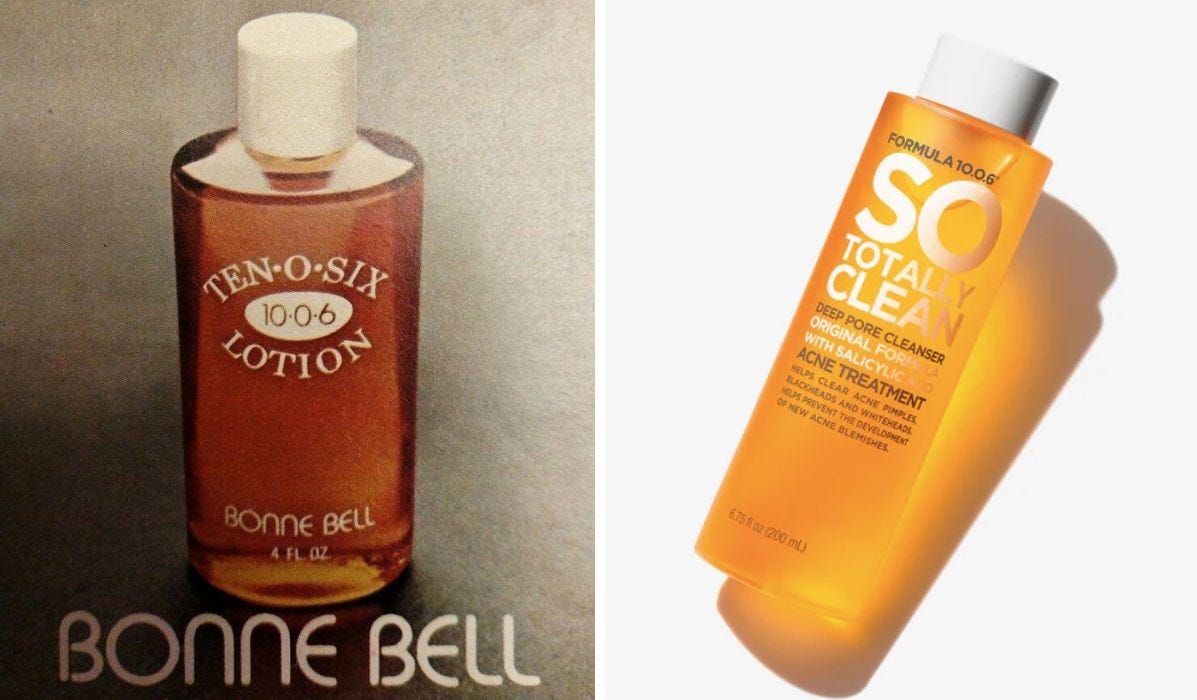
Were you a Seabreeze or a Ten-O-Six teen? I was the latter, and oh how I craved that burn. It probably explains why I love a sting-y acid now. Bonne Bell, makers of the famous Lip Smacker, used to own Ten-O-Six. When Markwins purchased the Bonne Bell and Lip Smacker brands, Ten-O-Six was not part of the purchase. It remained in the company formerly known as Bonne Bell, now called Aspire Brands.
Bonne Bell’s former HQ address was 1006 Crocker Road in Ohio. So clearly that’s how the original Ten-O-Six, created in 1933 (!) but popularized in the 1970s, got its name. In 2020, the brand entered the modern age: It’s now called *drum roll* Formula 10.0.6. This looks like it could be the name of one of Elon Musk’s children, but everyone knows dots are more high tech than dashes. Two young Bell sisters, Peyton and Hadley, who used to be featured in Lip Smacker ads, now run the brand. I love Ten-O-Six 2.0 very much just on principle. I have no idea how successful it is or will be.
(The above brands did not respond to requests for interviews to chat about their current iterations.)
Bliss
I think about Bliss, which started as a day spa in 1996, too much. Magazines made me care about it in my 20s, because it was featured everywhere. It was so chic! As a brand, it’s most famous for its “Lemon & Sage Body Butter.” (And most infamous for the cellulite cream, “Fat Girl Slim.”) In 2018, I wrote about an optimistic relaunch, at a lower price point and with some blatant dupes for younger-skewing buzzy brands in the assortment, to attract Gen Z.
In 2023, it was flipped to the company that owns ‘90s/Y2K brands Laura Geller, Mally Beauty, and Cover FX. While it used to be a premium brand, Bliss is sold at drugstores now. A Reddit thread a few months ago suggests that it’s getting harder to find. Its play for the youth demo seems to have failed. Now it bills itself “Skincare for Adults” and sells an “Elder Millennial” kit. This is so specific, and I just find it hilarious.
We Gen X-ers welcome you to the cultural relevance cheap seats, Millennials!
We are two Gen X journalists who celebrate people of our generation doing cool things, as well as analyze all the '80s and '90s nostalgia in current pop culture, fashion, and beauty. Read more stories like this one here!
You Oughta Know
Oprah is hosting a prime-time special about menopause, and of course it features WNVM menoposse main characters, Halle Berry and Naomi Watts. In a clip, Berry proclaims that women in menopause should get a “SHE-esta!!” (Does she mean the party or the afternoon nap? I’ll take the latter.) Someone on IG messaged me when I posted the clip: “I’m too gen x for this corny ass shit.” I think the SHE-I-A should arrest all of them. -SHEryl/cHERyl [Instagram]
Pedro Pascal and Jennifer Aniston were spotted having lunch in LA, and the rumor mill immediately jumped to “They’re dating!” Pascal said they were just having lunch. There was some joking about whether she would show up on “The Last Of Us” or he on “The Morning Show.” Personally, I like the totally speculative theory that she was pitching him to play the horrible Mr. Hart on the 9 to 5 remake she’s producing. -CW [Instagram]
In Audrey, a very dark and extremely funny Aussie black comedy, former aspiring starlet Ronnie (Jackie van Beek) takes over her comatose 17-year-old daughter’s identity to enroll in the latter’s acting classes for a life redo, and to ultimately bring her fractured family together. She also dons some ‘90s/Y2K-referential Gen Z wardrobe that will feel familiar, if not triggering, to us X-ers. The Guardian compares director Natalie Bailey’s debut to Todd Solondz’s unsettlingly comedic 1998 movie, Happiness, too. It streams on VOD platforms on April 1, or pre-order here. -FSH [Official Trailer]
If you missed out in the ‘90s on a DKNY logo tee or a grunge-y plaid dress that Winona Ryder could have worn in Reality Bites, a limited-edition, 40-piece DKNY Vintage collection goes live today at 3pm ET.-FSH [WNVM Inbox]
Speaking of the ‘90s, a lot of Gen X musicians and actors have been starting newsletters. Juliana Hatfield is the latest. -CW [Substack]
Congratulations, Neneh Cherry! The WNVM icon and groundbreaking music legend is a finalist for the Women’s Prize for Nonfiction for her memoir, A Thousand Threads, chronicling her upbringing and adventures spanning Sweden, London, and New York. Coincidentally, she’s also name-checked in a very sweet and lol Gen X/Z moment in the just-released third season of British coming-of-age dramedy, “Big Boys,” on Hulu. Highly recommend both! -FSH [AP]
The remake of 1989’s The War of the Roses will hit theaters on August 29, and I cannot wait to watch the supreme Olivia Colman eviscerate Benedict Cumberbatch in the roles originated by Kathleen Turner and Michael Douglas. The logline teases “a tinderbox of fierce competition [as] hidden resentment ignites.” -FSH [WNVM inbox]






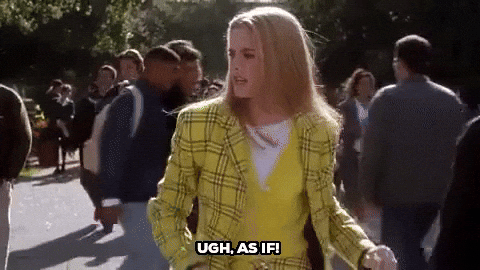


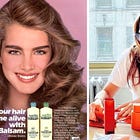

Has anyone noticed that in The White Lotus, Carrie Coon wears a pastel lilac that we probably never would have if it wasn’t for Hard Candy! But she also said on the official podcast that Laurie, as the odd one out, would always have an element that’s “wrong” and the nail color is one of them.
I used to love going to the Bliss spa in NYC in the early aughts!